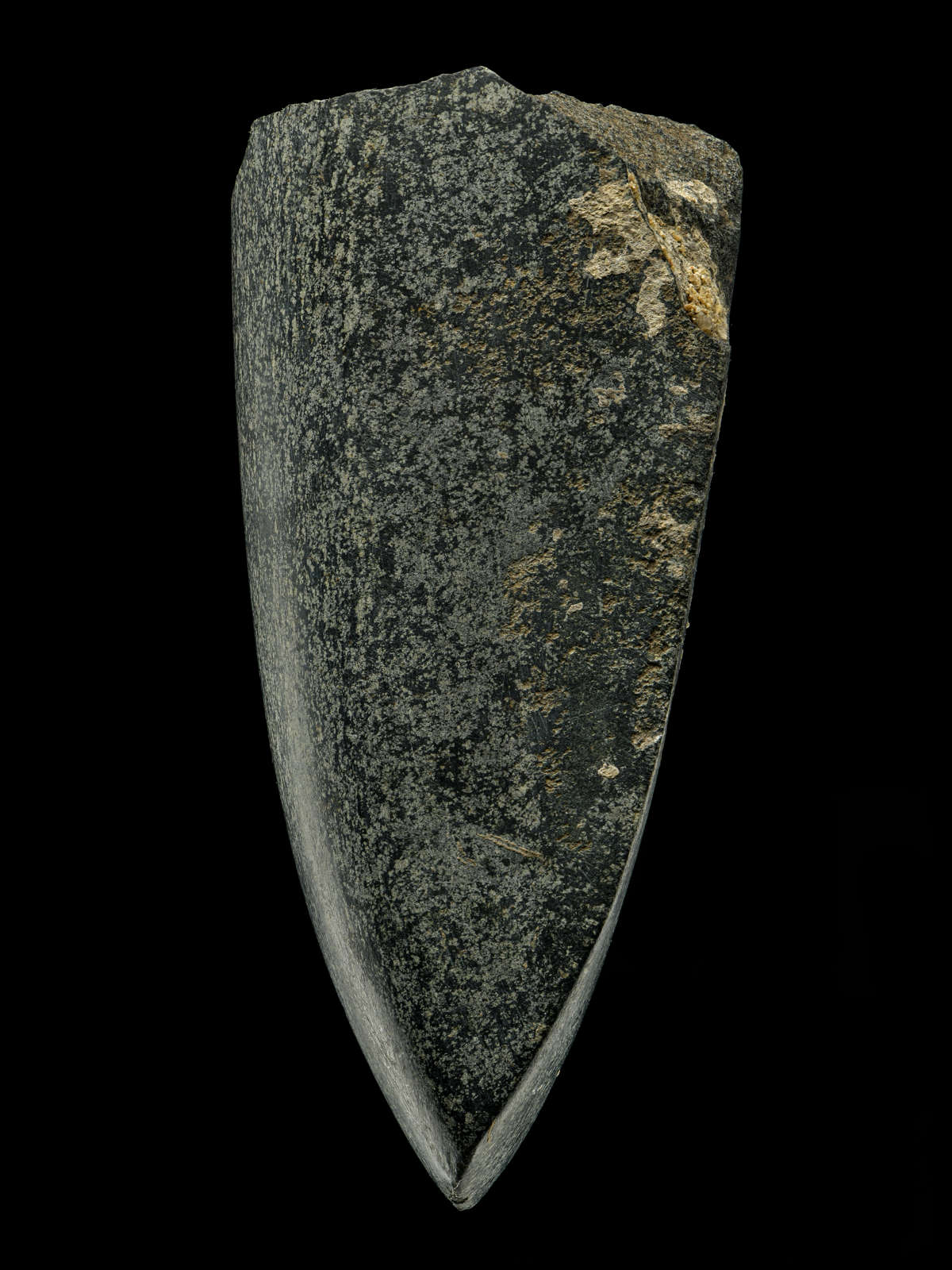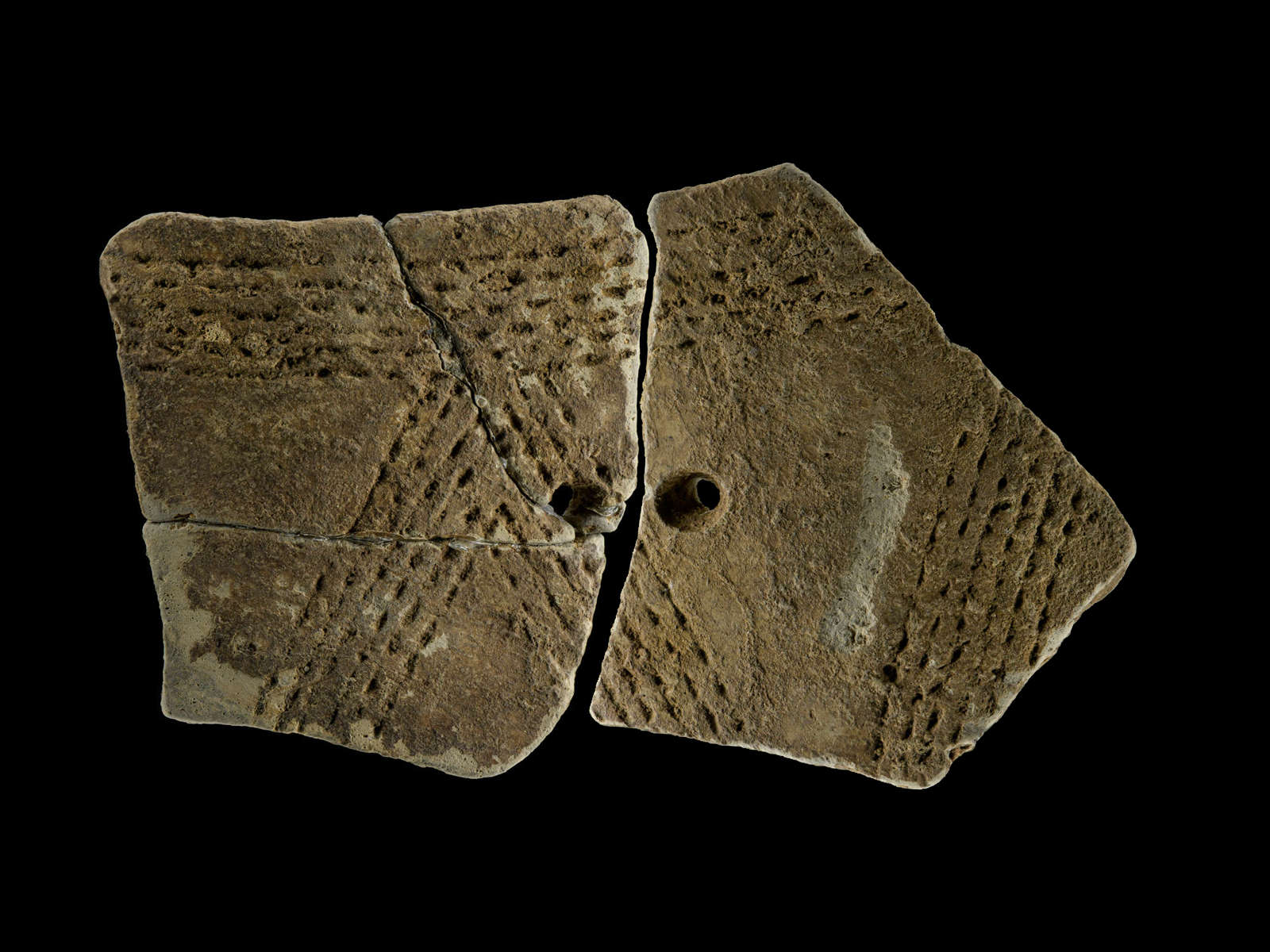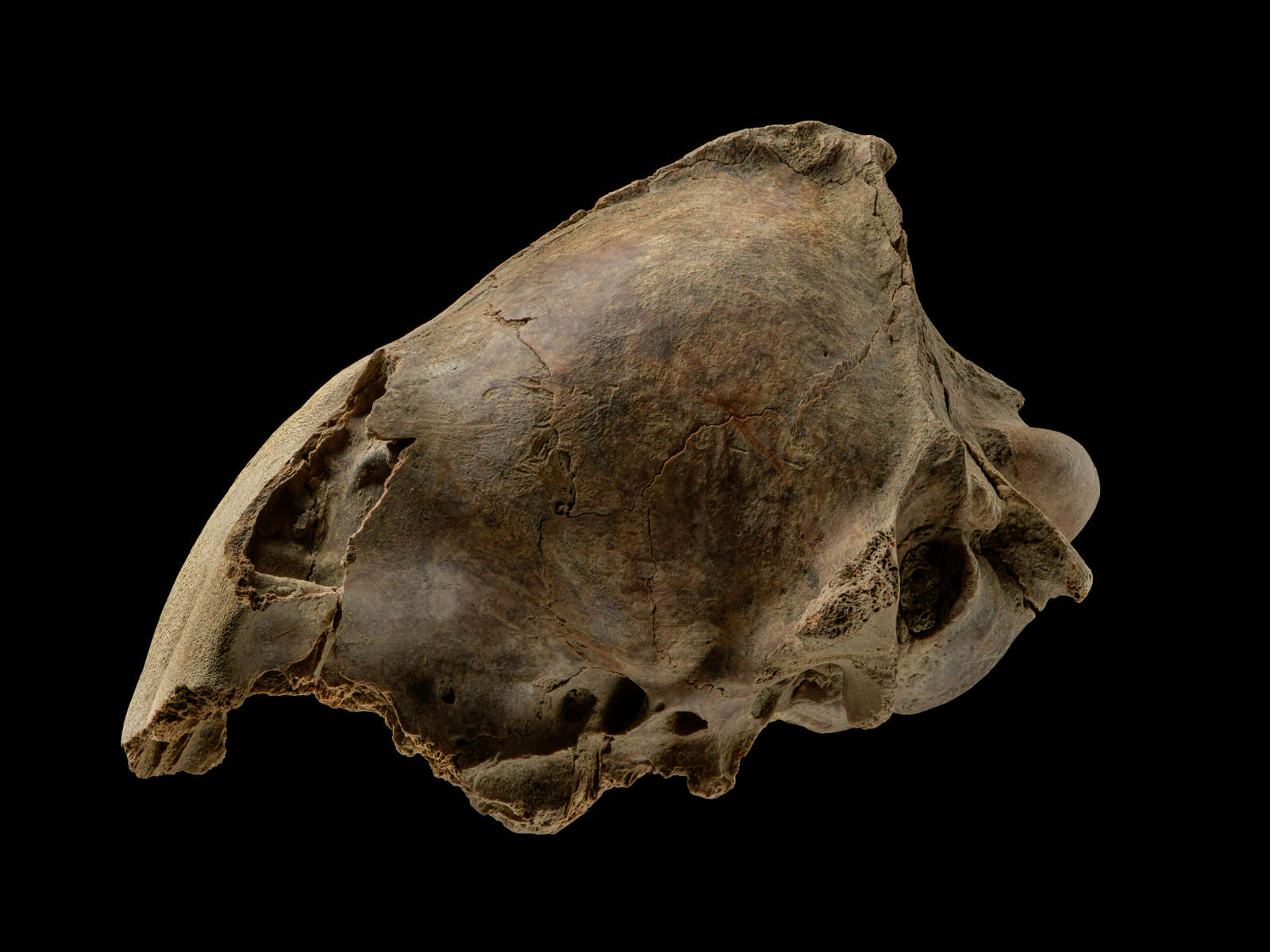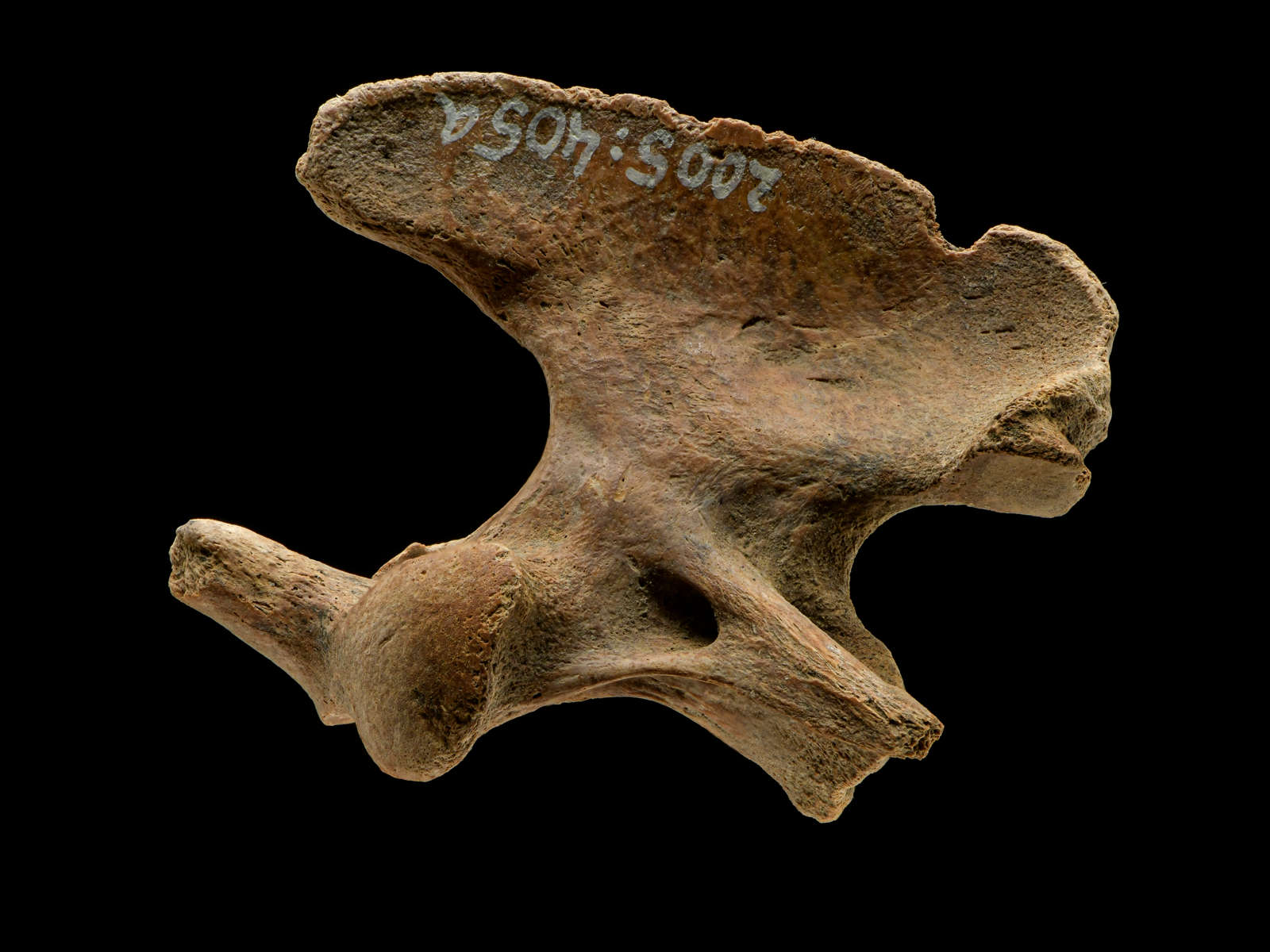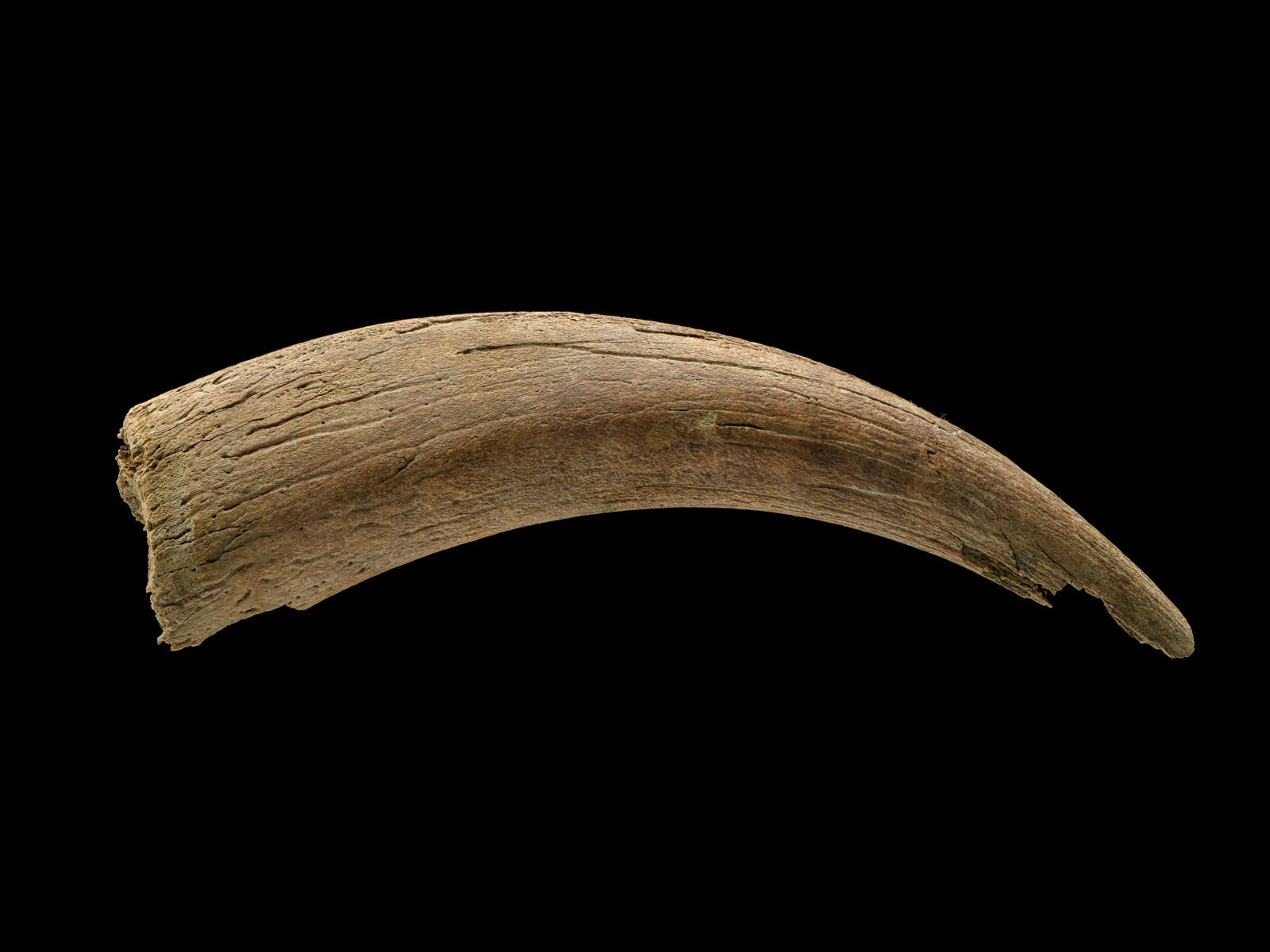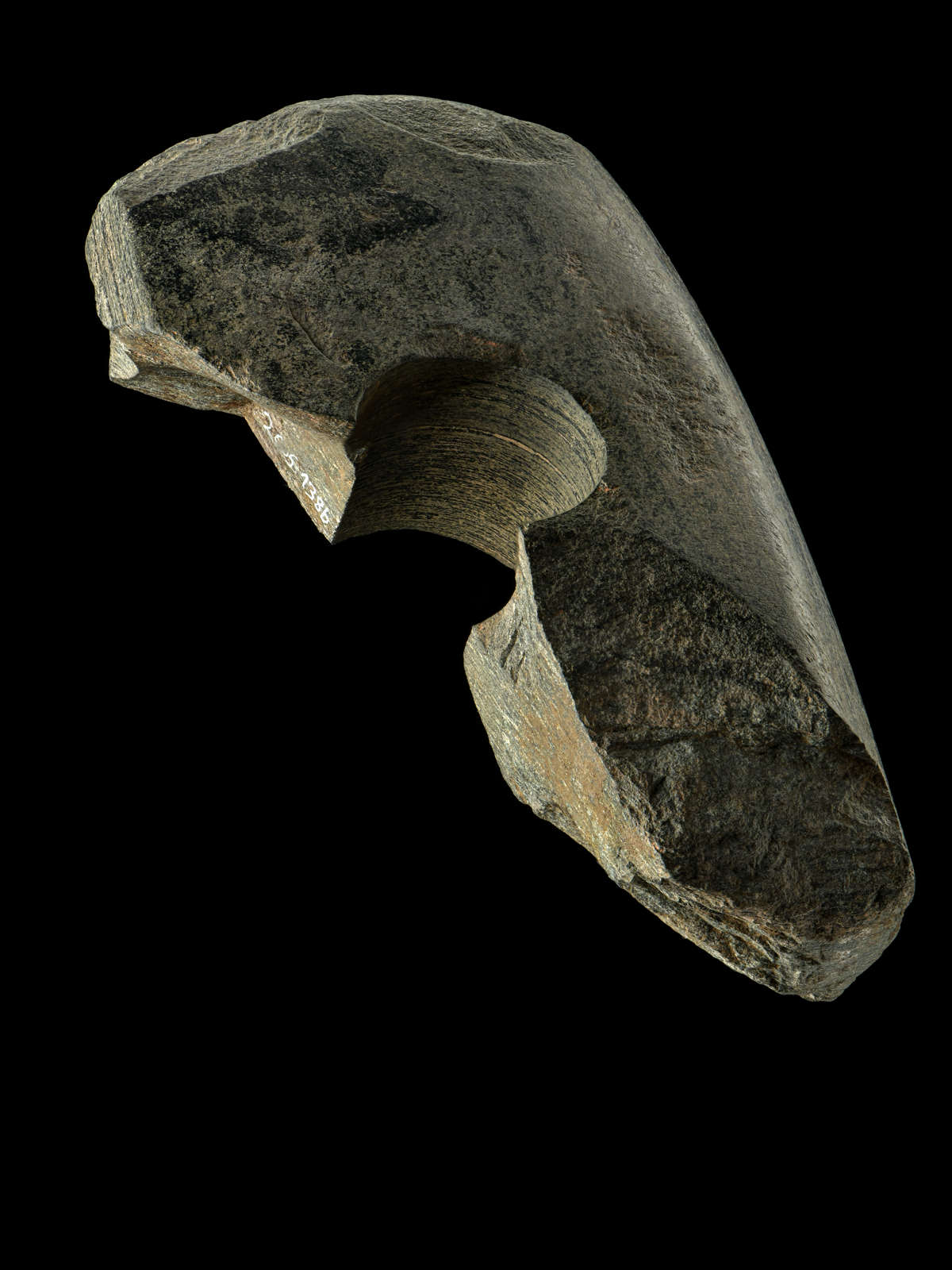The find material from the Goseck circular ditch complex mainly consists of pottery and animal bones. Smaller quantities of stone tools, flint flakes, and human skeletal remains were also found. A particular density of finds was found in the south-eastern quadrant of the site and at the entrance areas in the north, south-east, and south-west.
Explore the find material of the circular ditched enclosure interactively!
Behind each click point selected objects and additional information on the find context can be found.
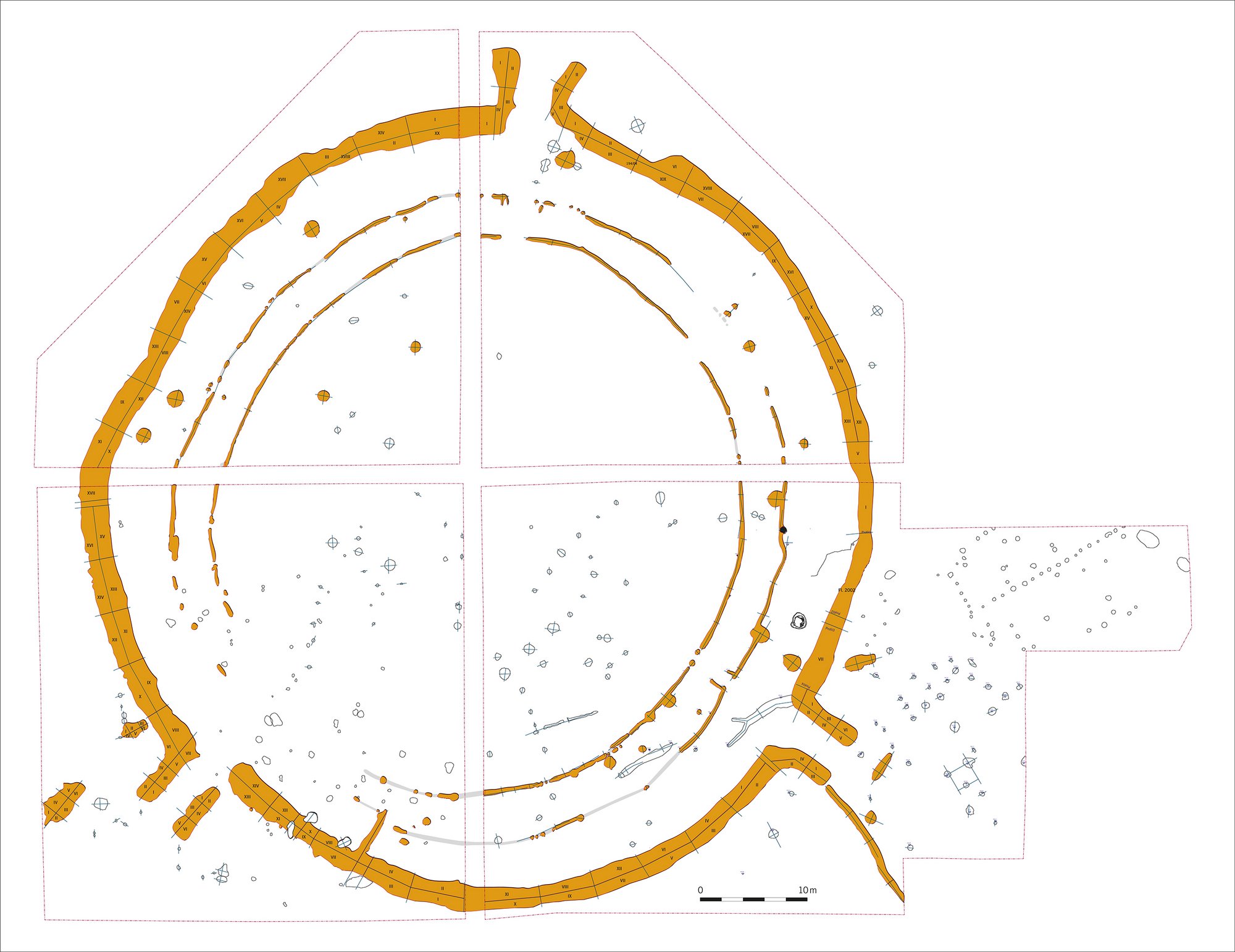
Miniature vessel of the Linear Pottery Culture
Child’s grave, feature Befund 48
To the east of the circular ditched enclosure, the excavators came across a child's grave of the Linear Pottery Culture (5500 to 4800 BC). The grave is clearly older than the circular ditched enclosure and therefore not associated with it. A 6 to 12-month-old infant was buried here lying on its left side in a flexed position directly adjacent to a probably contemporaneous building. The grave furnishings included two pottery vessels: An undecorated baggy pot, broken by compaction in the ground, and a completely preserved flagon with five lugs. This is decorated with the typical curvilinear patterns of the Linear Pottery Culture and isosceles triangles. The original is on display in the information centre at Goseck Palace.
Pit, feature Befund 97
The elongated pit immediately in front of the south-eastern entrance area lies on the extension of the sight line through the gate jambs and could possibly also be connected with the bearing of the sunrise. Not only did the pit contain an unusually large amount of find material, but some of the objects themselves are also exceptional.
The pit contained numerous fragments of local stroke-ornamented pottery, flint implements, and animal bones as well as two pottery fragments of the Middle Neolithic Grossgartach Culture (4900 to 4700 BC), which was widespread in south-west Germany at about the same time as the stroke-ornamented pottery. Thus there are indications of supra-regional contacts at Goseck.
A radiocarbon date could be obtained from the animal bone material, which dates the filling of the pit to the period between 4796–4727 BC, and thus to the main phase of use of the site.
Flint hoard, feature Befund 170
Flint implements and flakes belong to the largest find group within the lithic find material with more than 700 individual objects. An impressive find inventory in this context comes from feature Befund 170 in the north-western sector of the circular ditched enclosure. The pit is special in several respects: The roughly circular pit had a diameter of 1 m. It was, among other things, filled with large stones, which had also been placed around the edge of the pit. Possibly it was intended to mark the pit above ground. This feature is one of the richest in the entire excavation area: it contained sherd fragments of several vessels, more than 2 kg of animal bones and a find assemblage consisting of more than 40 flint implements and flakes, which, according to the find context, had been deposited all at once. The pit is therefore interpreted as a deliberately assembled hoard. The decoration of the recovered sherds points to the older Stroke-ornamented Pottery Culture.
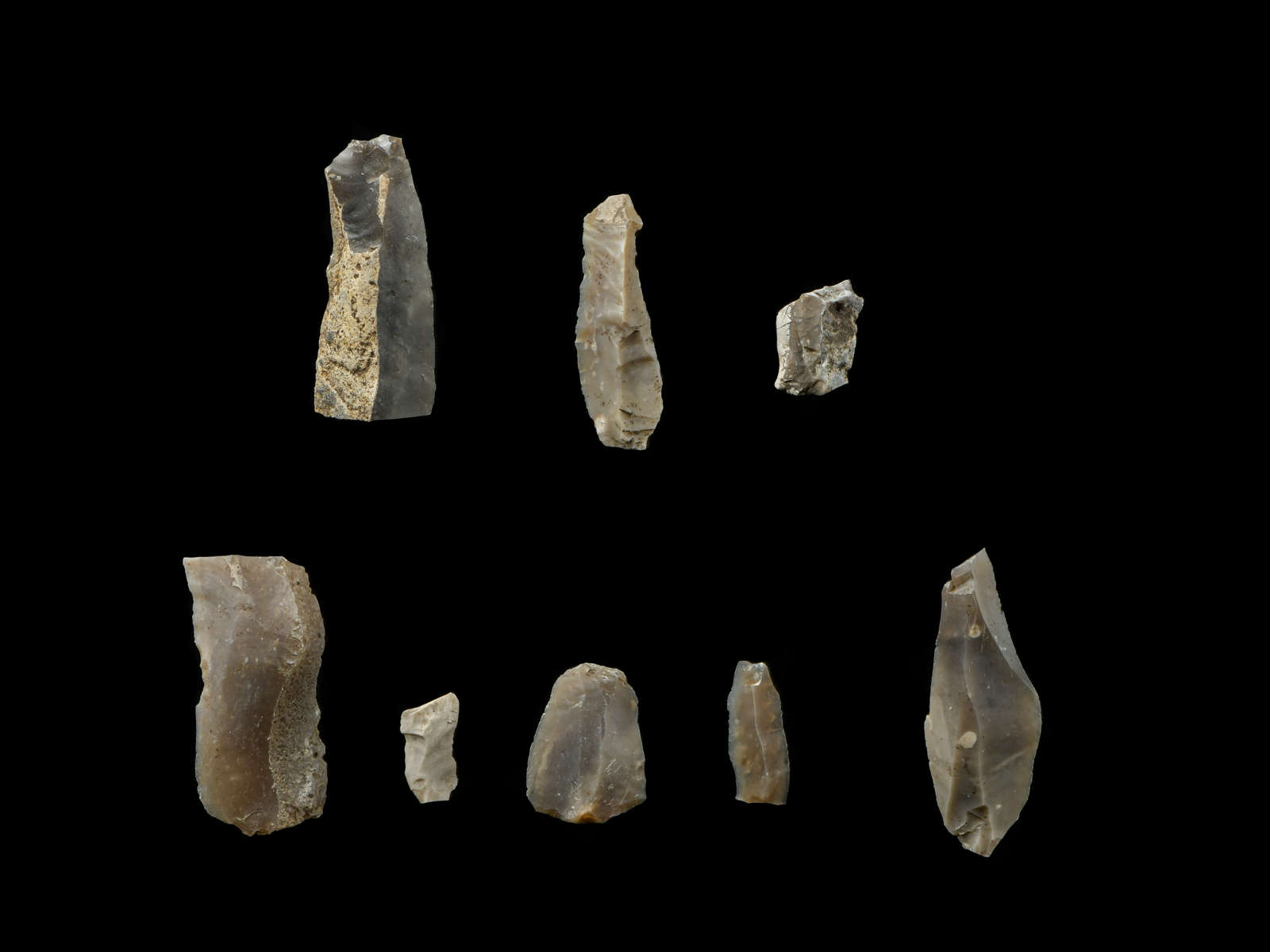
Imported flint
The different colouring of the flint processed in Goseck shows that the flint came from different deposits. Particularly high-quality flint was imported from remote regions. One example of this is a triangular arrowhead from feature Befund 170.
Pit containing a human hand, feature Befund 129
Pit Befund 129-3 is one of the few features from the area of the circular ditched complex that contained human skeletal remains (see also feature Befund 139-3). The feature shows that there are two successive pits which overlap. The trough-shaped pit, measuring about 2.8 x 1.2 m, was still preserved to a depth of 50 cm. Similar to feature Befund 139-3, the red-coloured natural gravel, fired clay, and a layer of ash again showed traces of the intensive agency of fire.
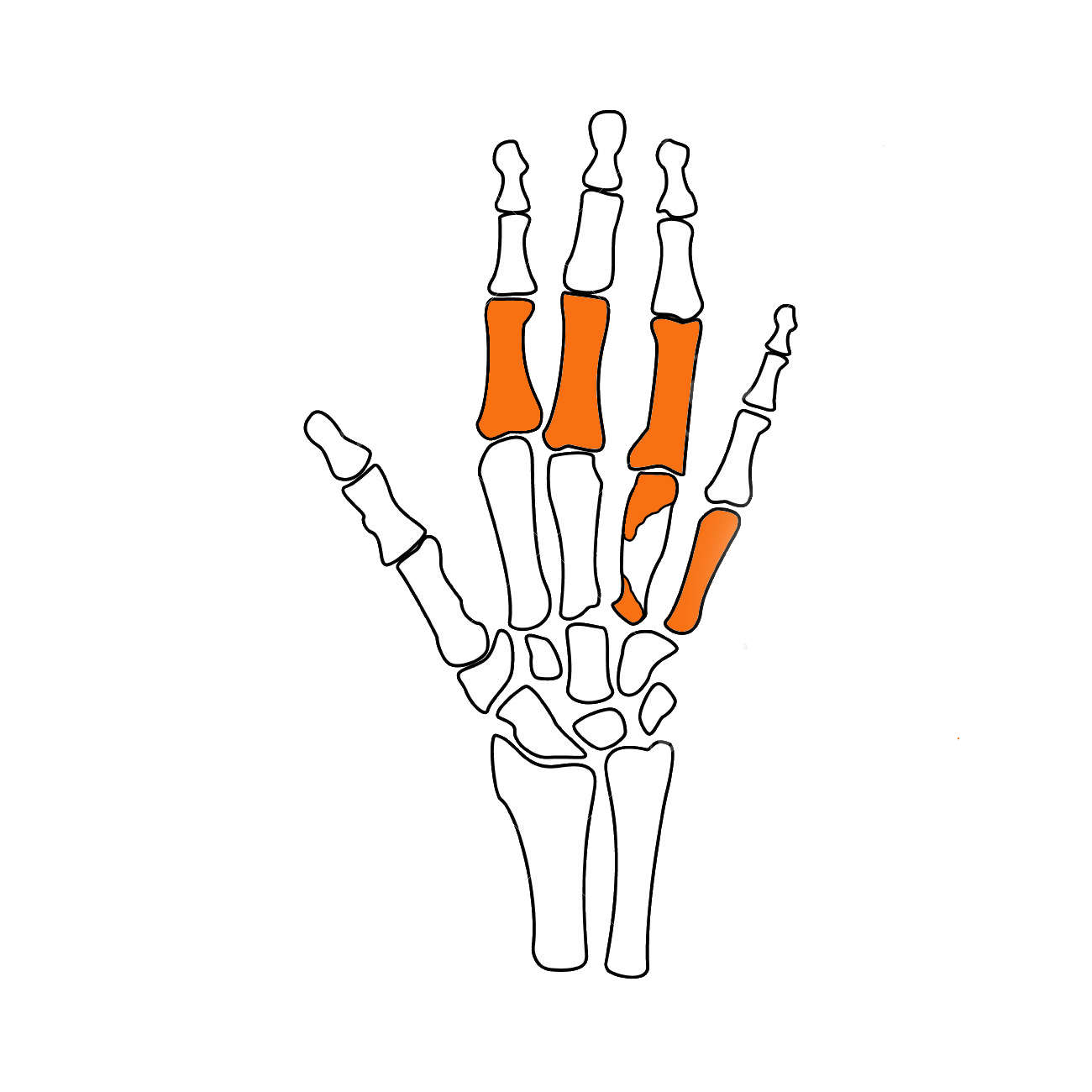
Remains of a right hand
The fill of the younger pit contained five finger and metacarpal bones of a human right hand. The bones were deposited in anatomical association and belonged to a juvenile/adult male. An absolute date could be obtained from a bovine bone, dating the pit to the early Stroke-ornamented Pottery Culture (4830–4729 cal BC, MAMS-16390, 1 Sigma) and thus to the construction period or early period of use of the site. Stroke-ornamented Pottery sherd fragments confirm the dating.
The pit lies outside the ditch, in the area where also the earthen bank is assumed to have been. It is therefore possible that the pit existed already before the construction of the circular ditched enclosure. Norma Henkel, on the other hand, assumes that the pit was accounted for by a gap in the earthen bank, which was constructed as a segmented earthwork, and was thus not built over.
Bovine skull & horn cones
In the area of the circle ditch, a conspicuously high density of bovine skulls and about a dozen horn cones from cattle were found. Cattle are also by far the most frequently represented species in the animal bone inventory of the circular ditched enclosure. The special significance and mystical exaltation of cattle in the Neolithic period can be grasped in many Neolithic cultures, especially at numerous circular ditched sites.
For the Goseck circular ditch complex, various interpretations open up as to what role cattle might have played in the construction and use of the enclosure. Cattle skulls could have had a decorative function in the gate areas in the sense of bucrania (architectural decorative elements in the form of cattle skulls). At the same time, animal sacrifices and the consumption of cattle as part of banquets for special celebrations and gatherings are conceivable.
Rim sherd with unusual decoration
In the north-western sector of the site there are four conspicuous pits. They lie between the circular ditch and the outer palisade ring and contained a particularly large number of finds, including above all, animal bones and pottery.
Two rim sherds from feature Befund 173 show extraordinary decorations, which in this form are unique in the find material from Goseck. They date back to the early Stroke-ornamented Pottery and thus to the construction period or early period of use of the circular ditched complex. It is possible that the finds are some kind of foundation sacrifice.
Pendant, from feature Befund 194/04-IV
This fragment of pottery was probably reused as a jewellery pendant. This is indicated by the secondary perforation and the abraded broken edge of the sherd. Sherds converted into amulets are attested multiple times in stroke-ornamented ware.
The find comes from the filling of the ditch of the northern gate and can possibly be interpreted as a votive offering. The gate jambs contained further finds suggesting ritual acts, among them fragments of pottery with pitch adhesions and fragments of particularly high-quality vessels.
Pit containing human skeletal remains
A deviant burial?
In the south-eastern area, the outer palisade cuts a pit of about 1.6 x 1.3 m in size. Pit 139-3 is unusual for several reasons:
The walls of the pit were heavily scorched - an indication that once a fire burnt here. Pits with traces of fire are found in Goseck at several places in the circular ditched enclosure. In addition to the agency of fire, however, this pit also contained human bones of an adult individual, which raises questions about the use of the enclosure in the context of ritual acts: Only parts of human extremities were found, bones from the torso or the skull were missing. Since the bones were no longer in anatomical association, it can be assumed that they were deposited in an already partially skeletonised state.
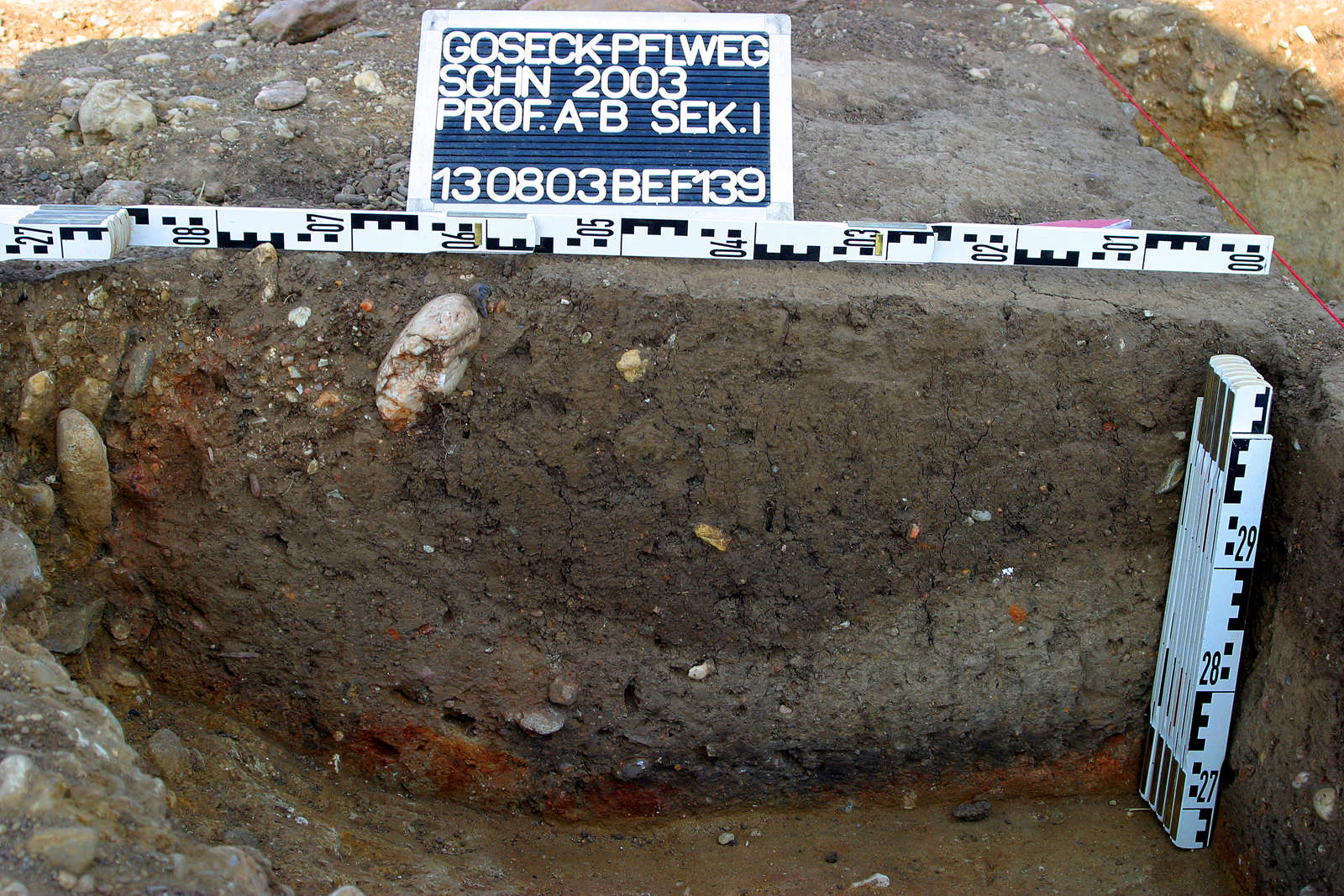
When the enclosure was built, it seems that the pit was respected, because the outer palisade is interrupted in the area of the pit. Apparently, the pit had a special significance for the builders of the circular ditched complex. Several fist-sized stones at the upper edge of the pit possibly served to mark the pit.
The most recent finds are fragments of the early Stroke-ornamented Pottery Culture. The pit can thus be dated to the construction period of the circular ditched enclosure.
Fragment of an adze
Together with another fragment of a stone axe and a grinding stone, this adze fragment belongs to the only find objects made of stone with a find context. All three objects were recovered from the middle to upper fill layer of the circular ditch near the gate openings. Like the flint implements, the stone axes also show clear signs of use.
Vessel with repair holes, GE 193-18
These two rim sherds of a Stroke-ornamented Pottery baggy pot exhibit different traces that indicate a repair of the vessel. Several fragments were provided with repair holes. Black adhesions on the broken edges further indicate that the pot had been glued with the help of pitch. The use of pitch as an adhesive, among other things for the repair of ceramic vessels, is attested multiple times in the stroke-ornamented pottery. The repair of the vessel shows that it was of special importance to someone.
Dog skull & goat horn cones
This dog skull was found together with a cervical vertebra bone in the fill of the circular ditch. As the other skeletal parts are missing, a ritual decapitation and deposition of the skull is conceivable.
In addition to horn cones of bovines, horn cones of other animal species were also sporadically found in the circular ditch. These include two specimens of goat horn cones, both from the circular ditch in the area of the south-west gate.
Stone axe
The perforated, fragmented amphibolite stone axe was found in the area of the south-eastern gate of the circular ditch. A second stone axe has a similar context at the south-west gate of the circular ditch (feature Befund 380/04-IV).
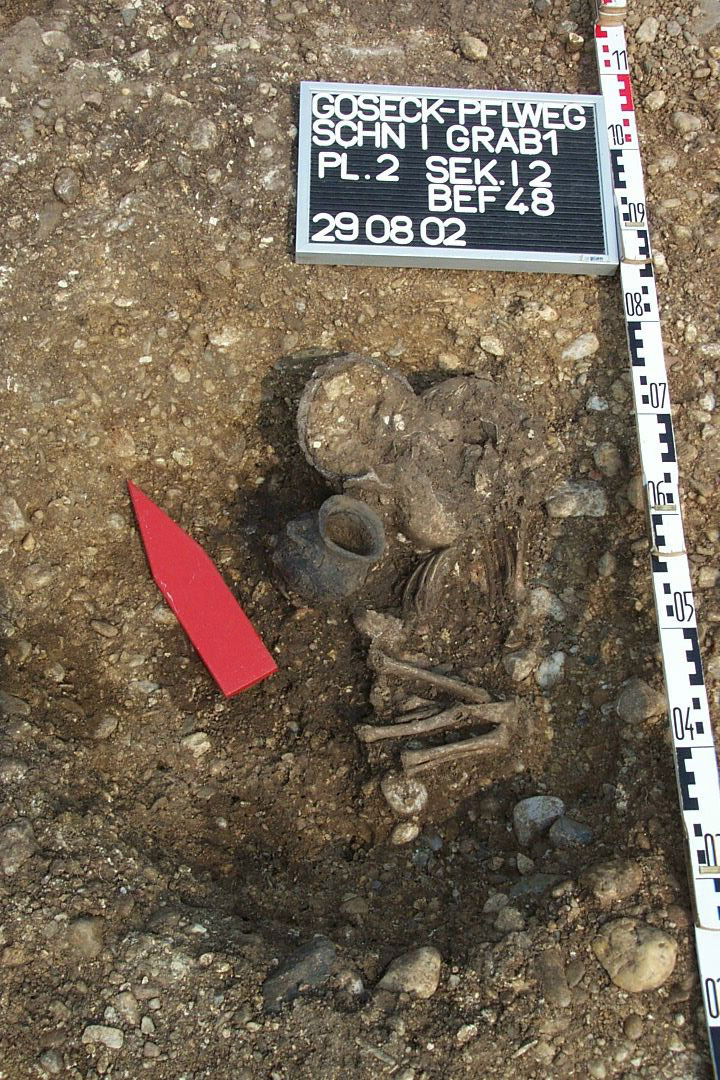
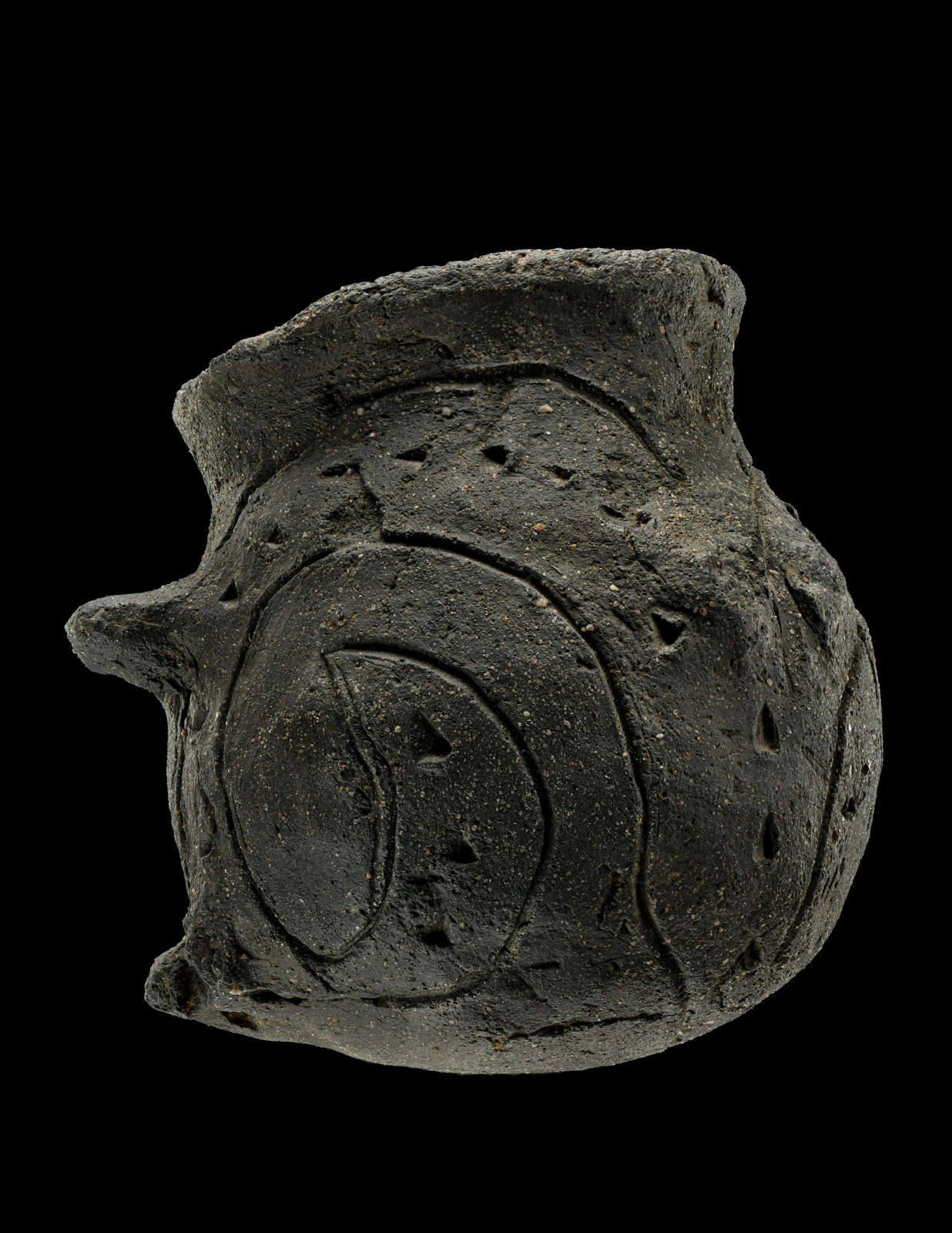
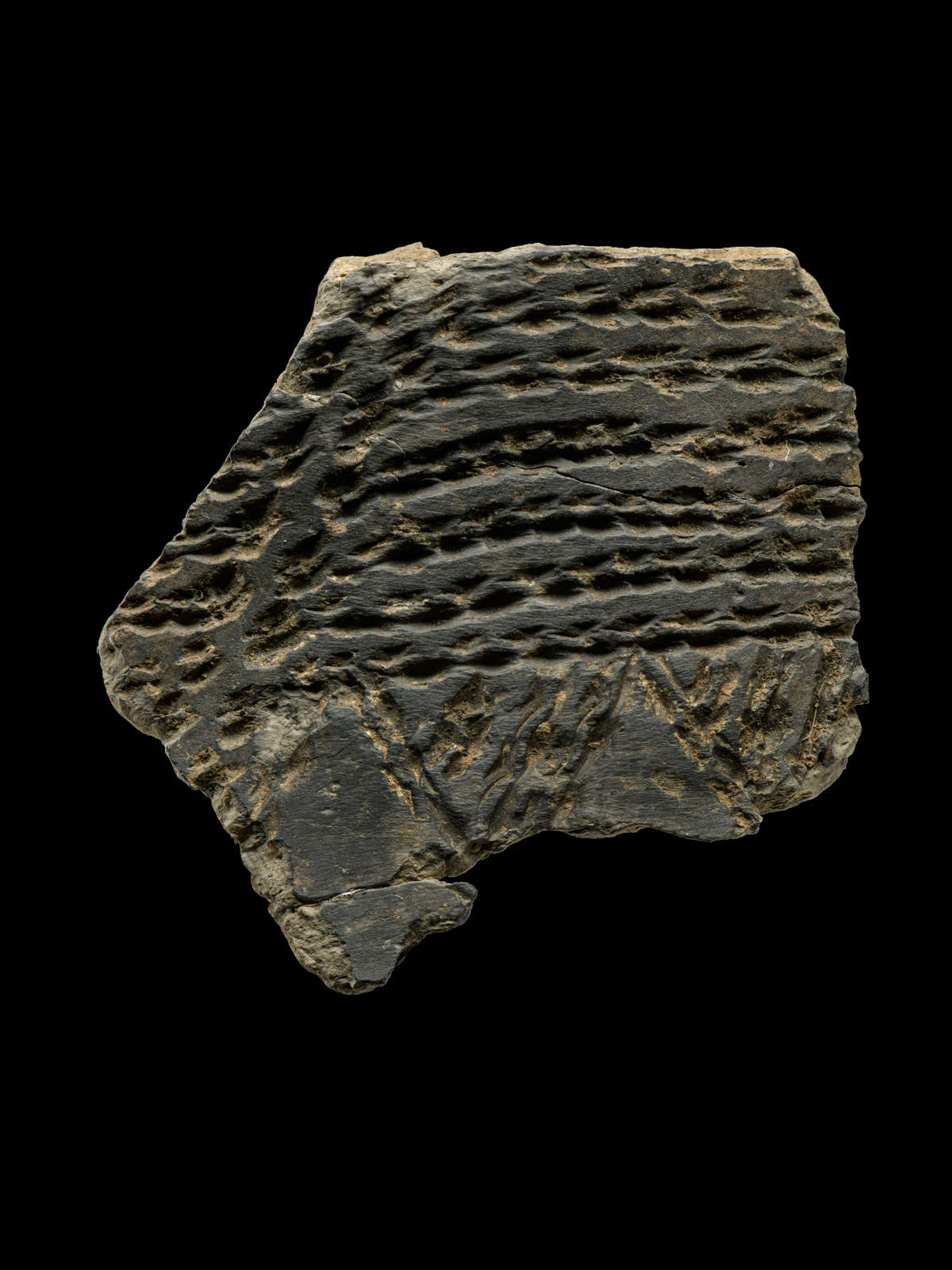
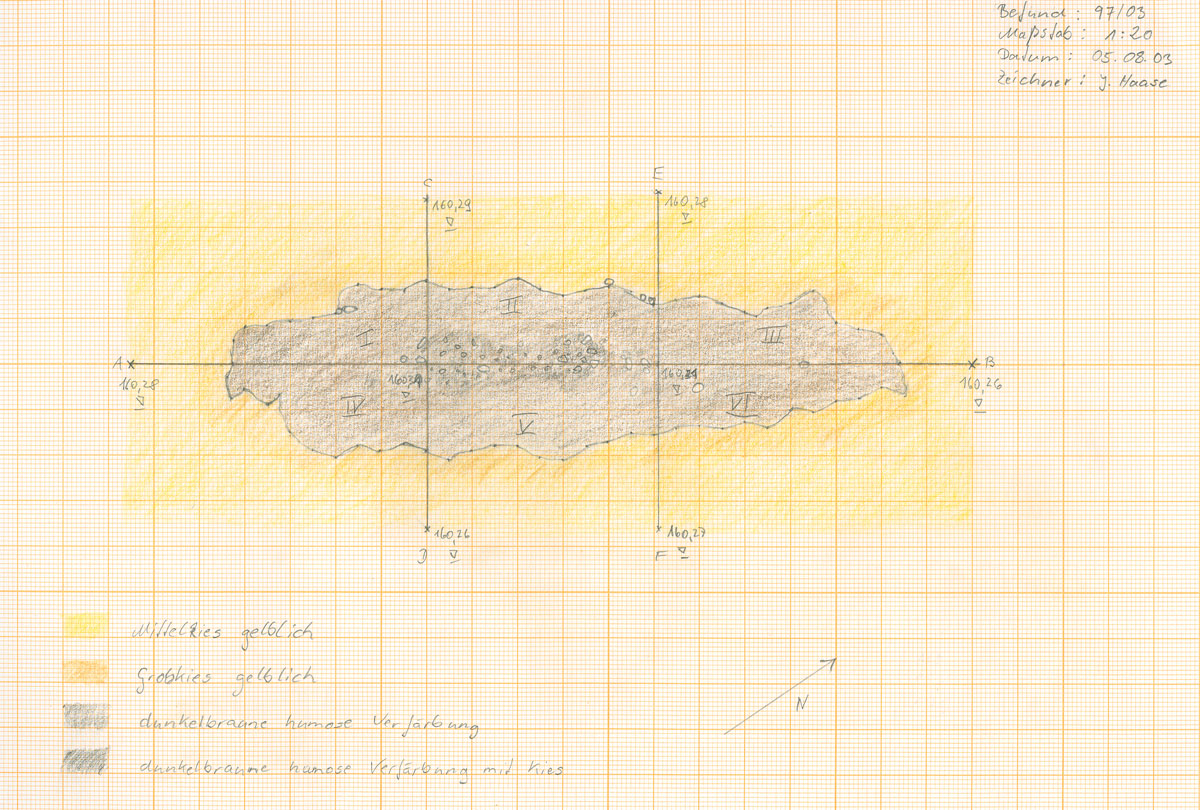

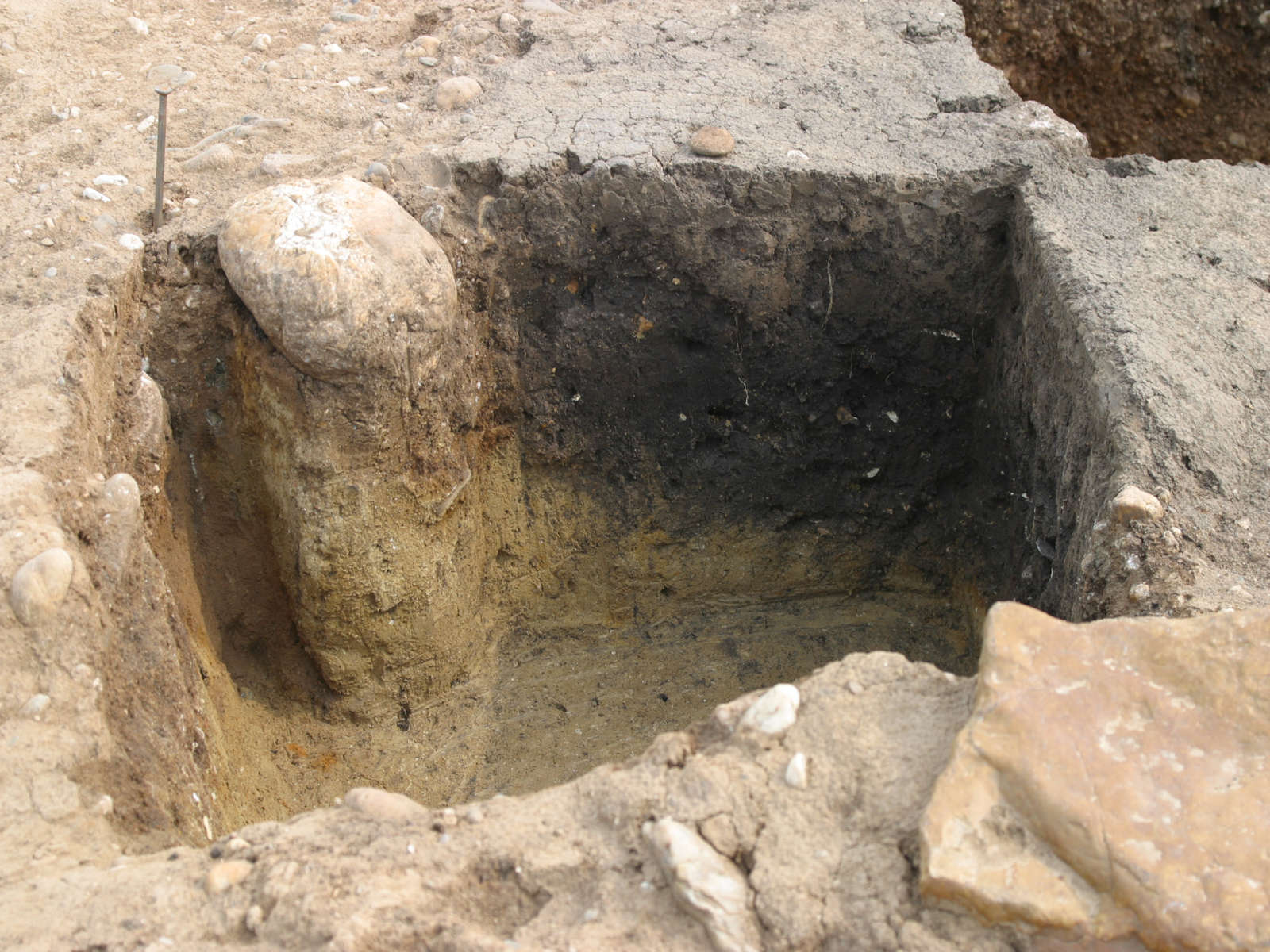
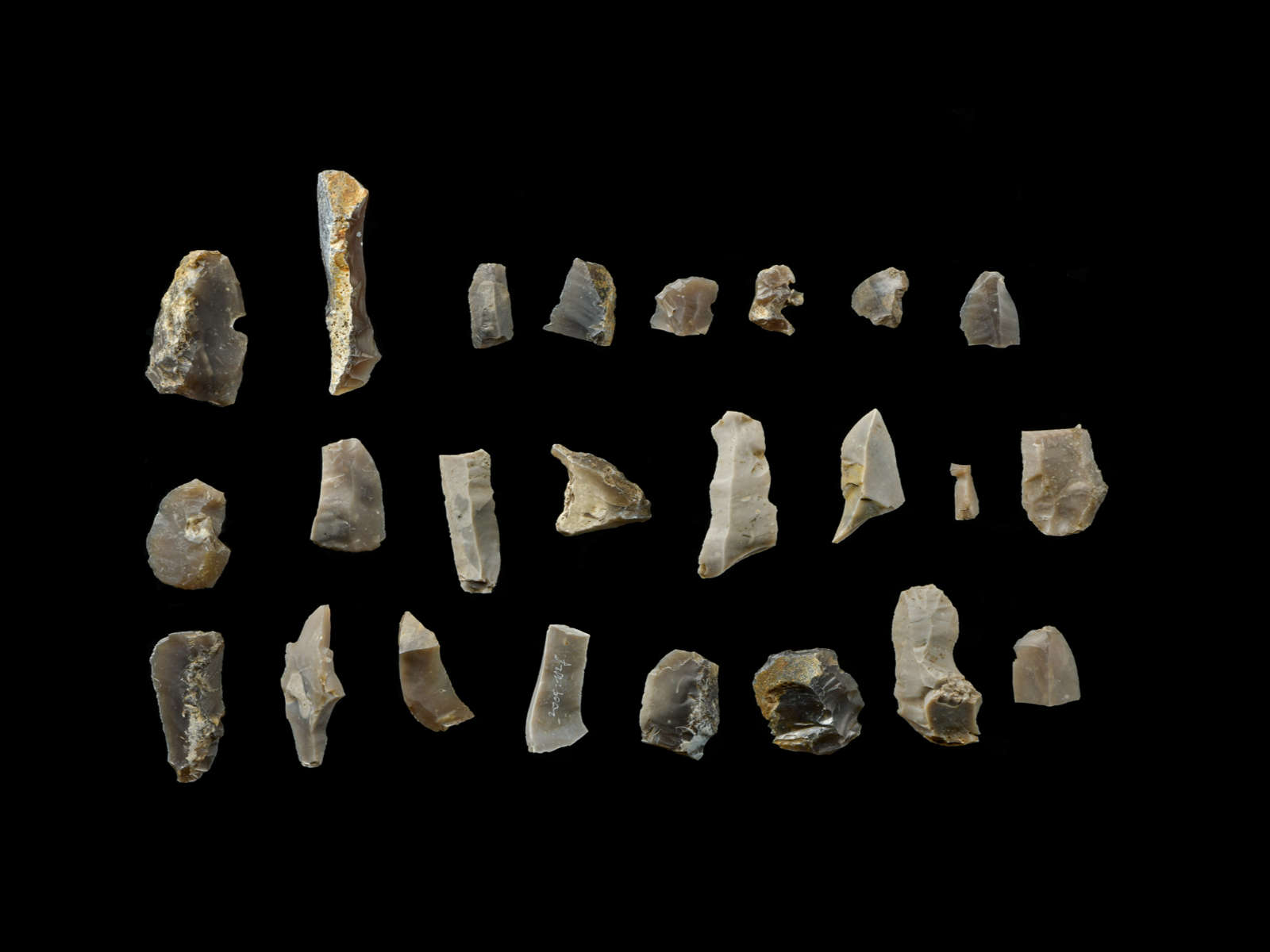
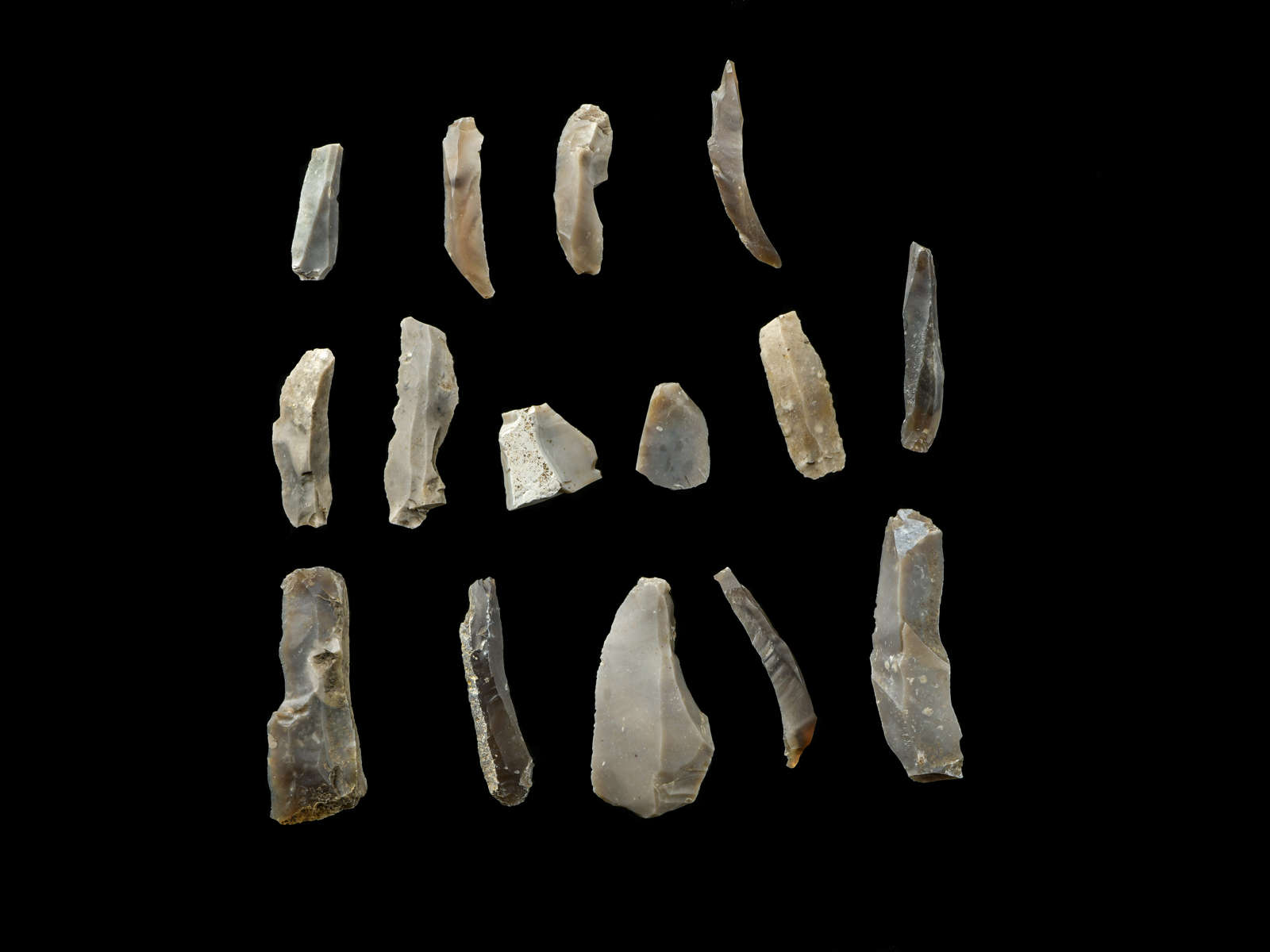
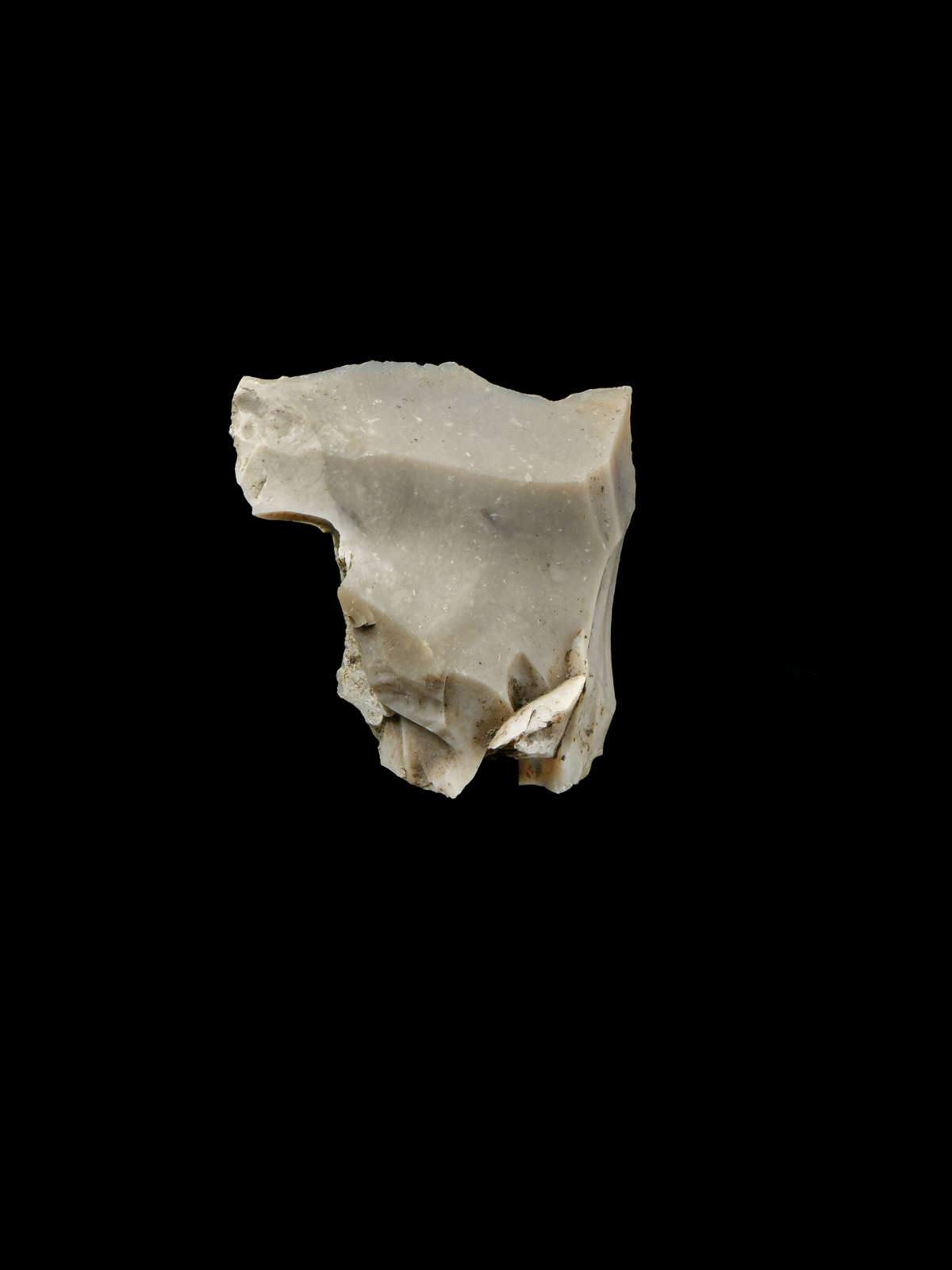
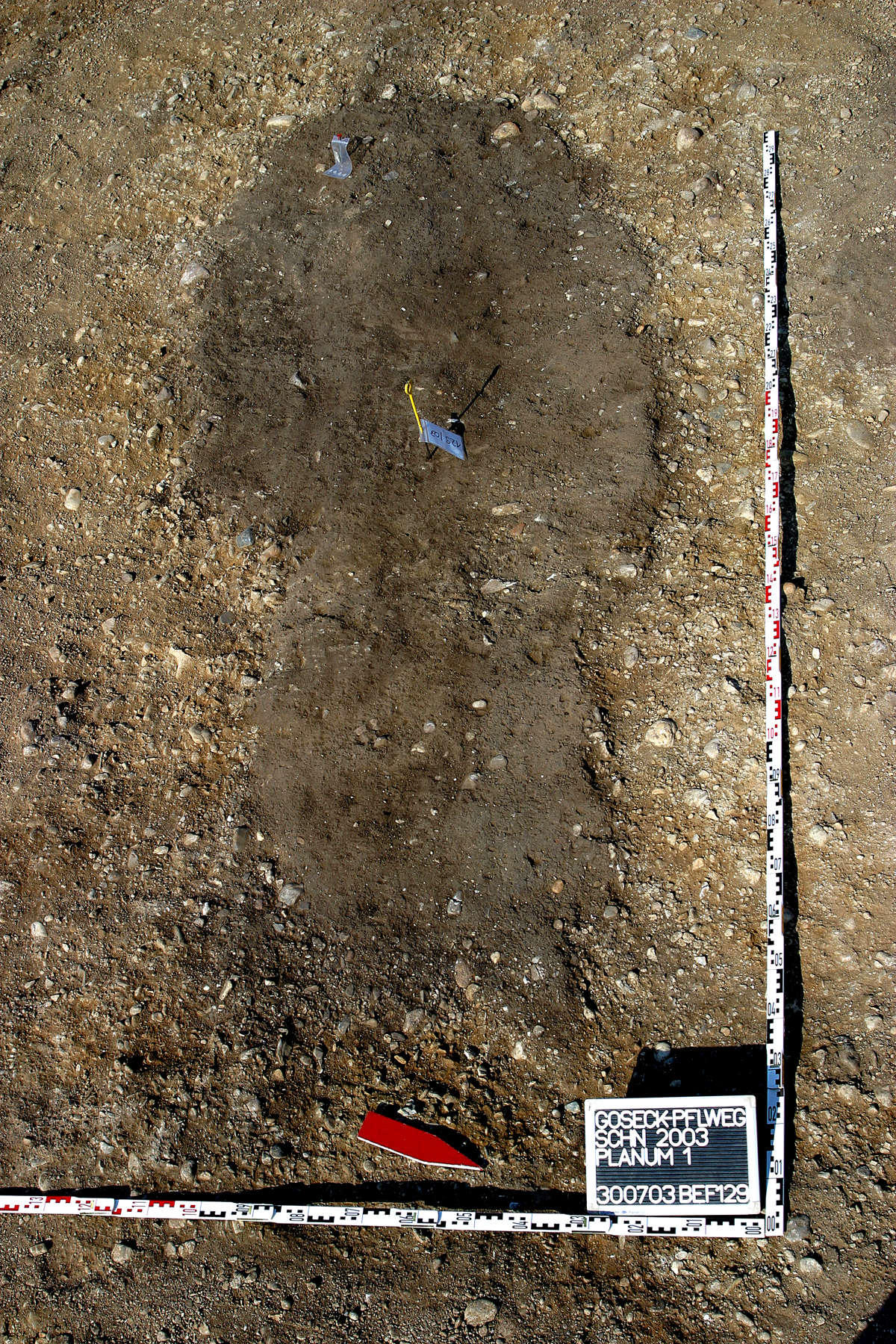
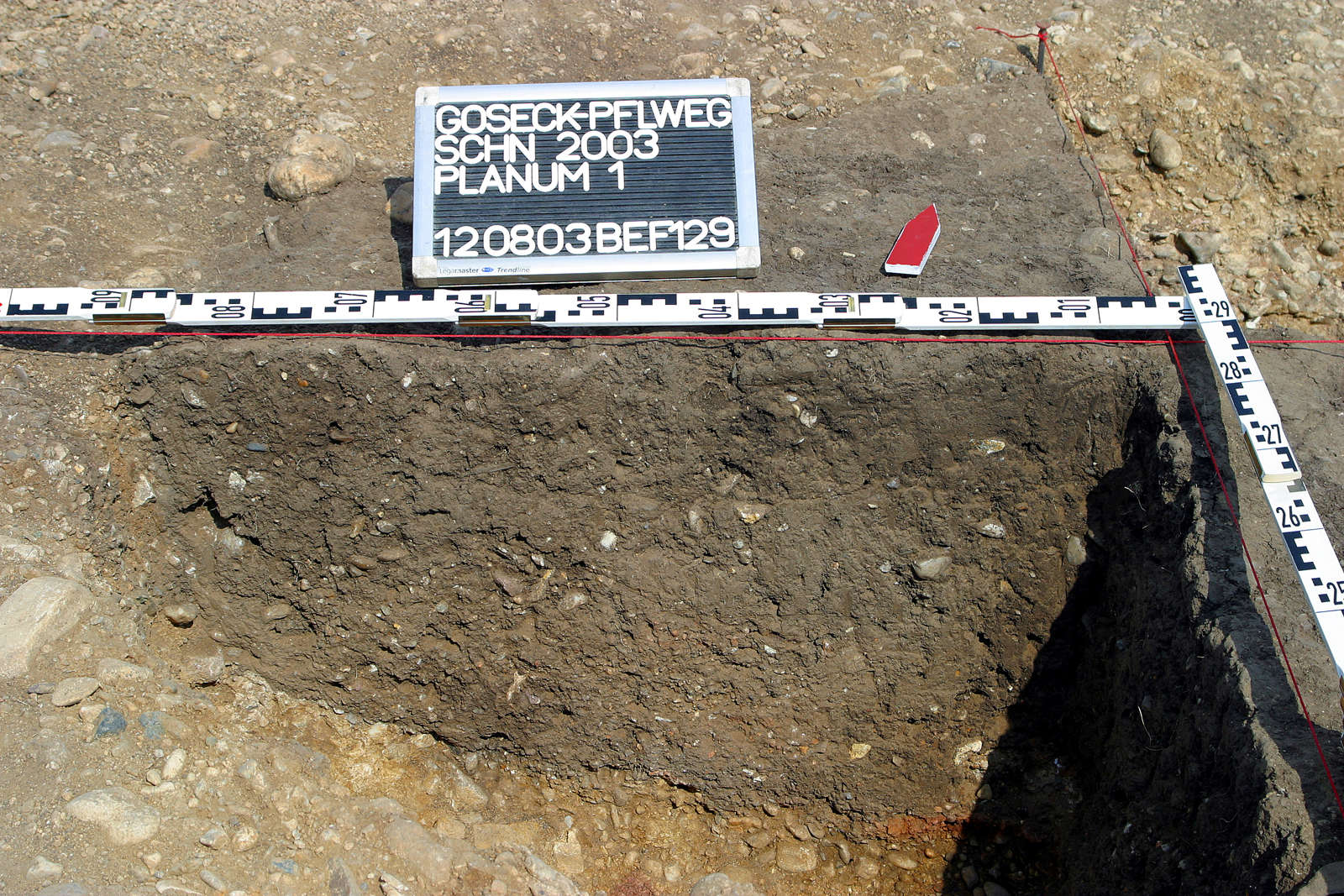
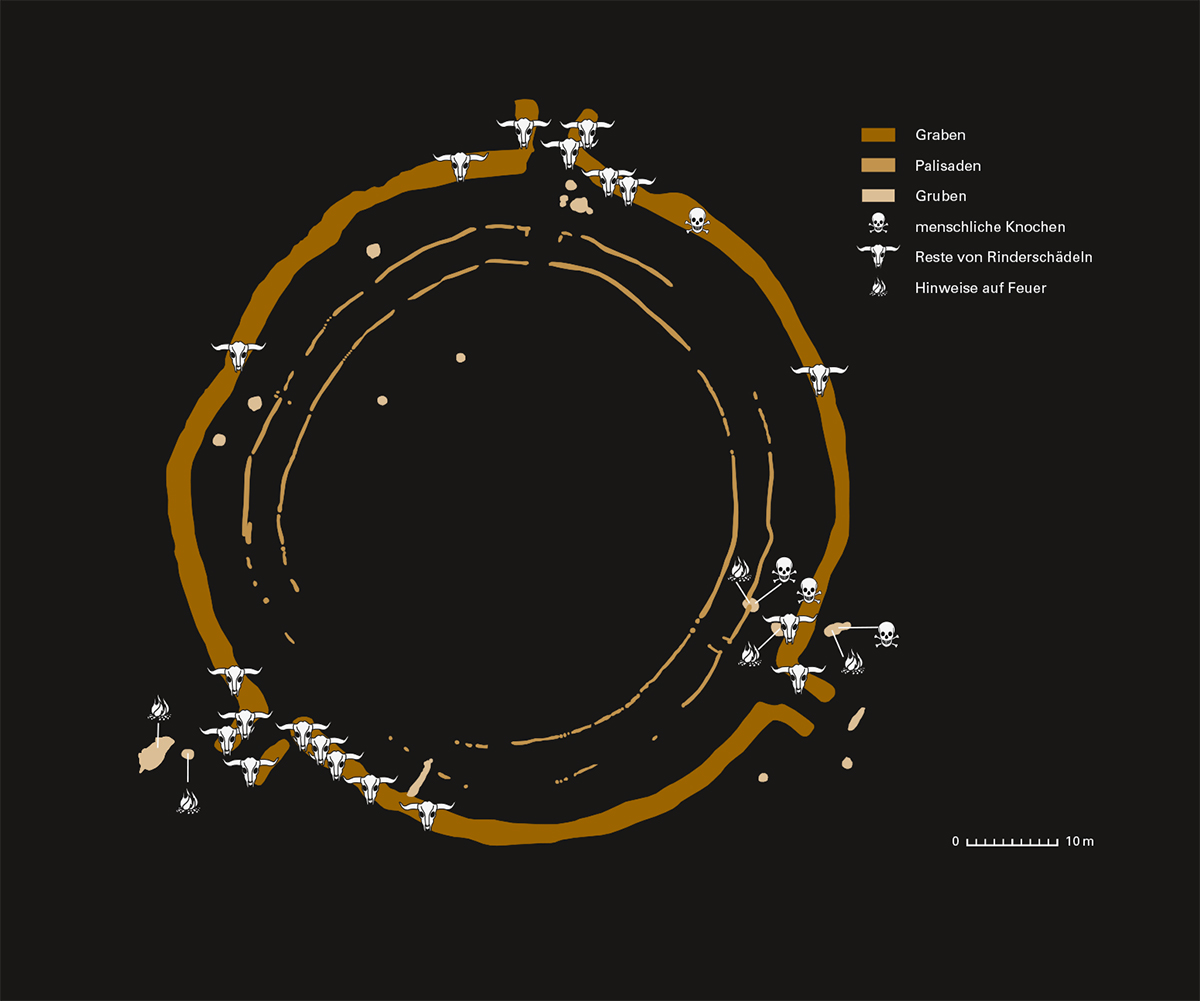
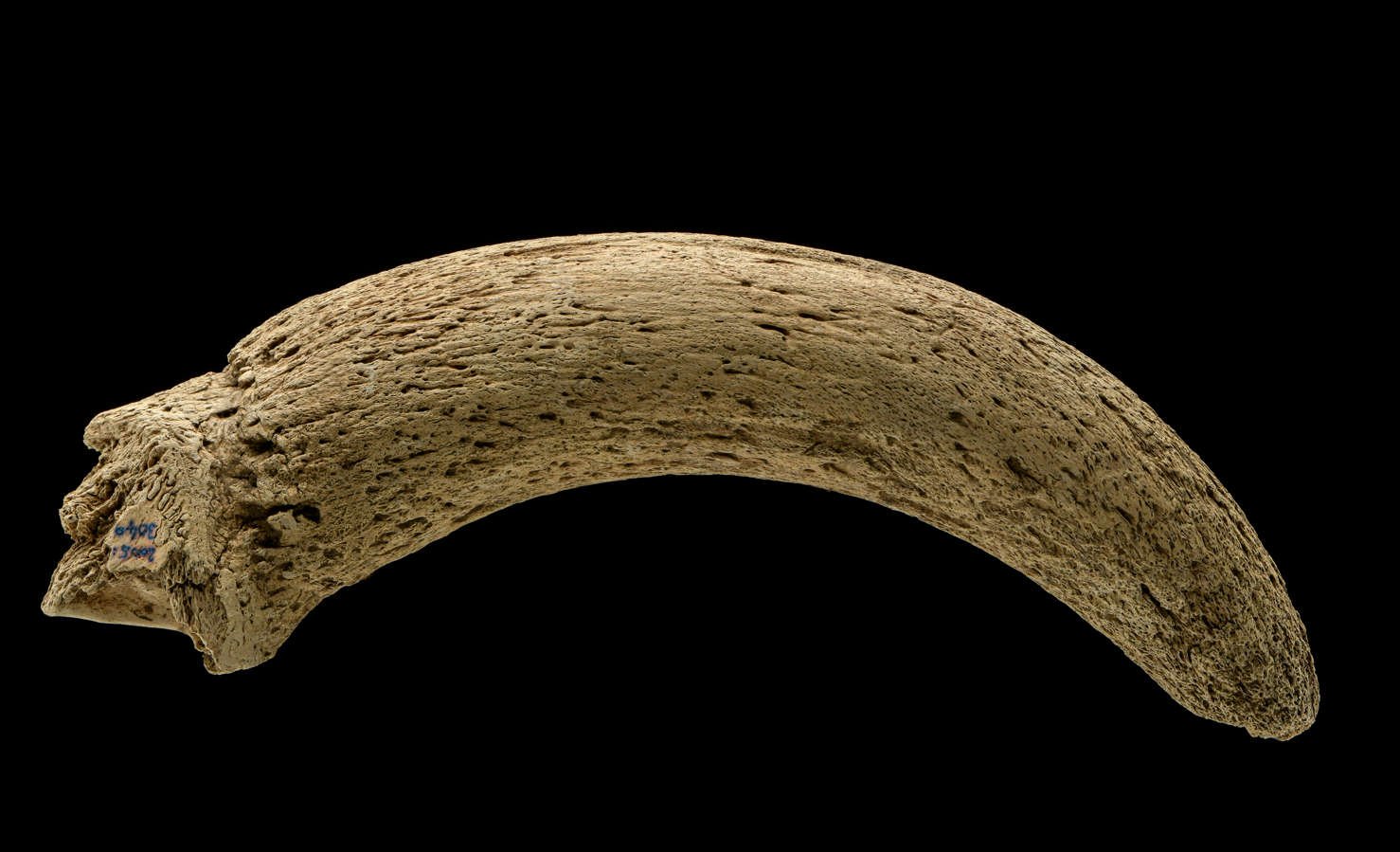
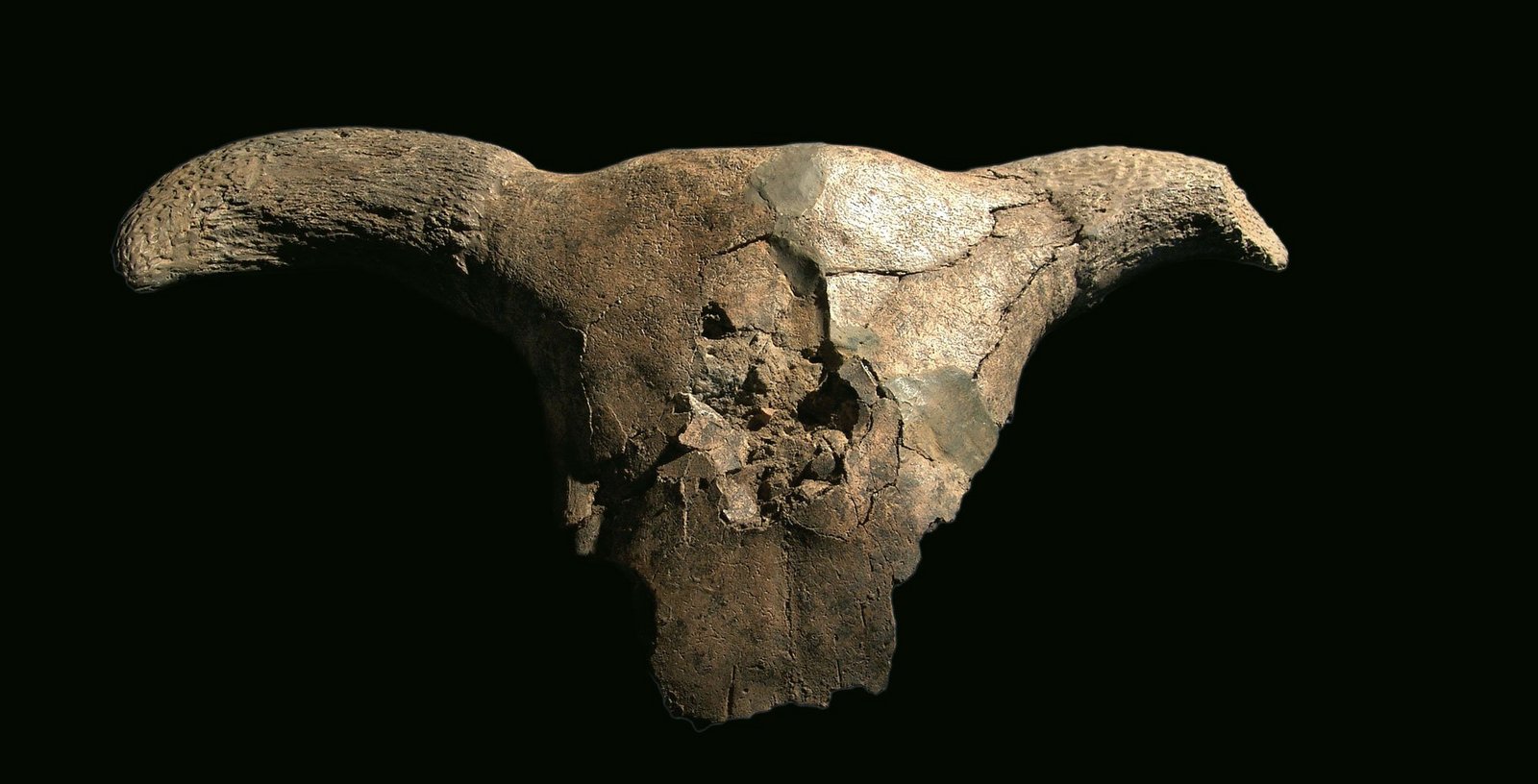
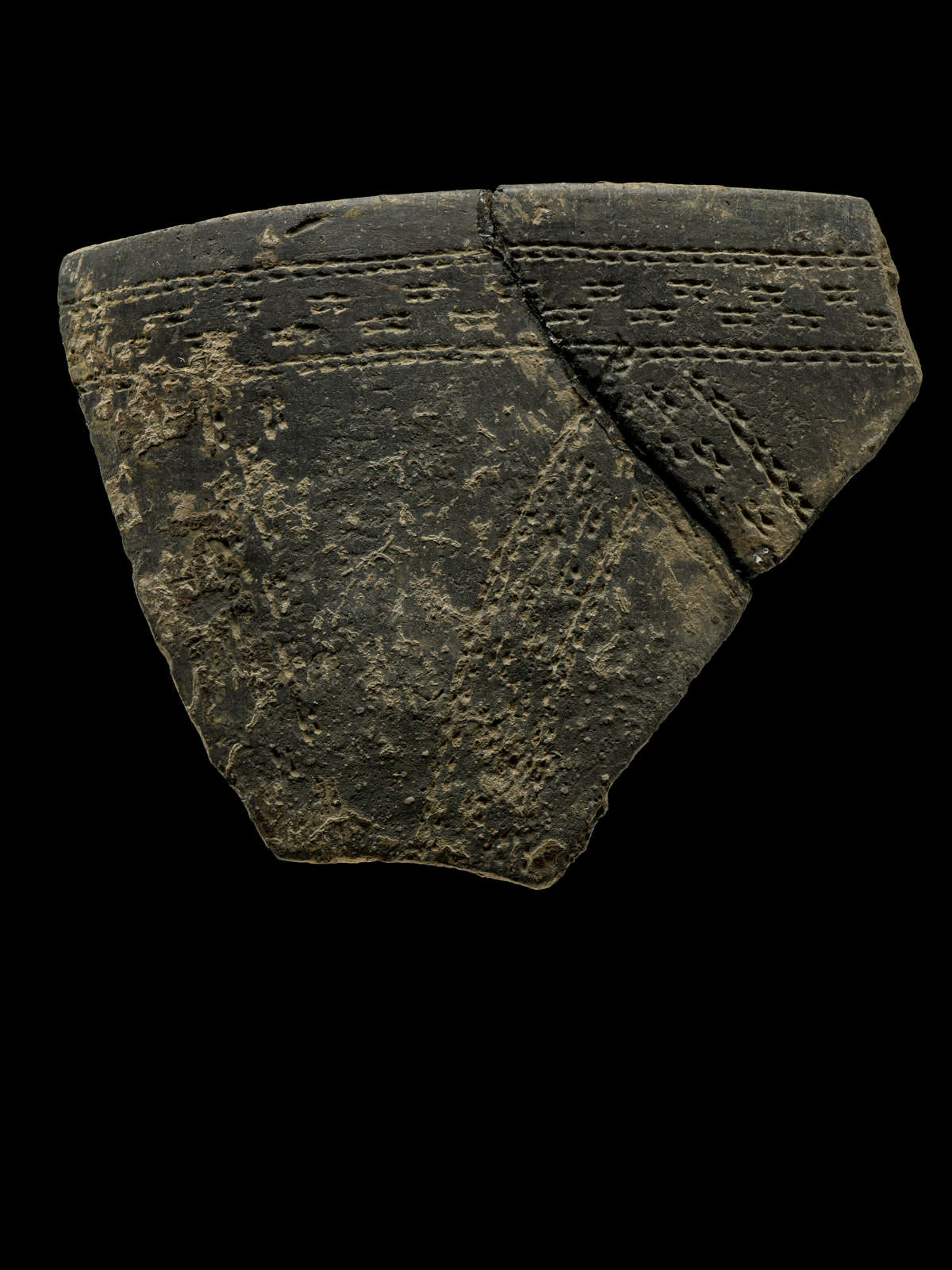
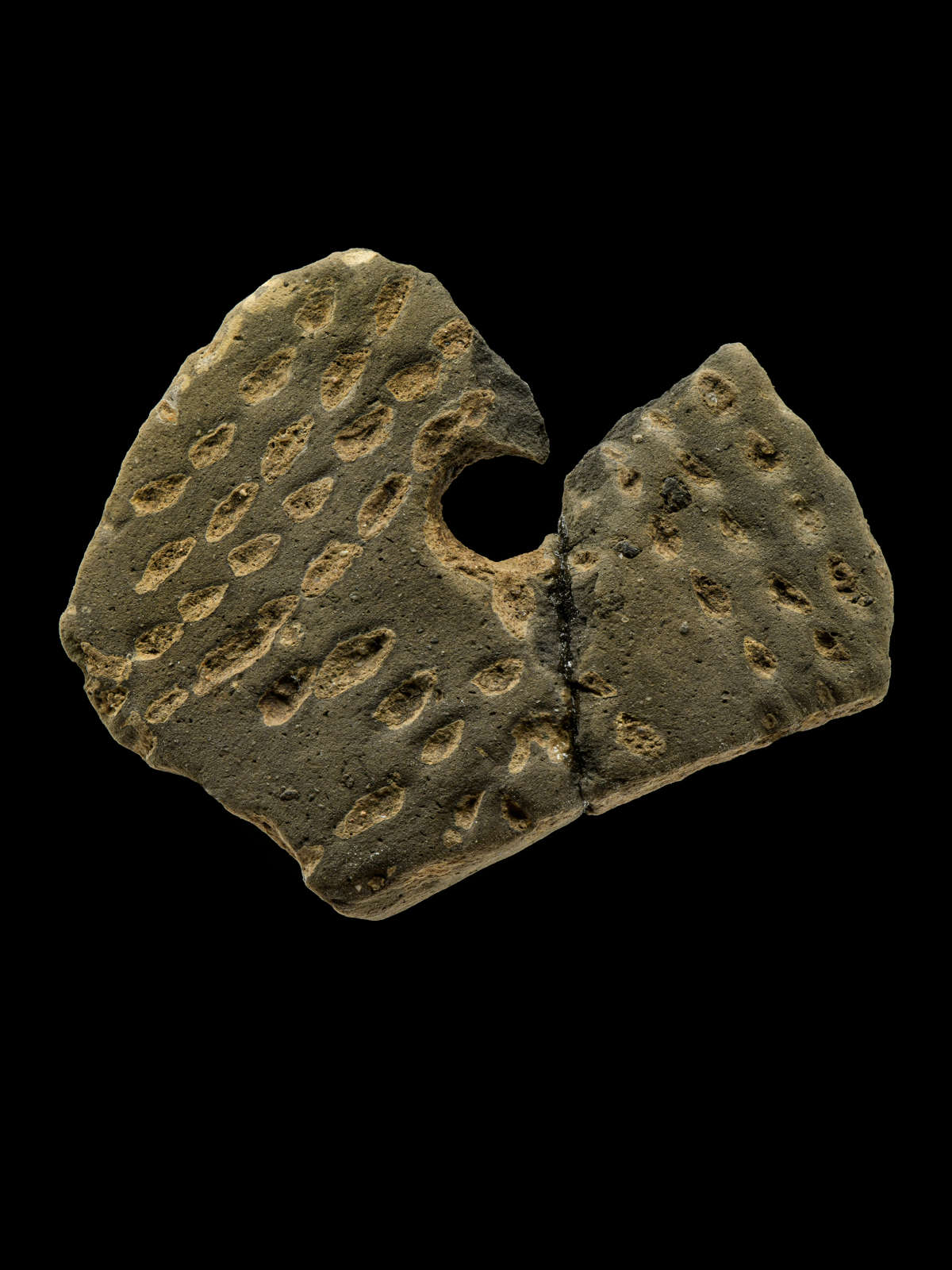
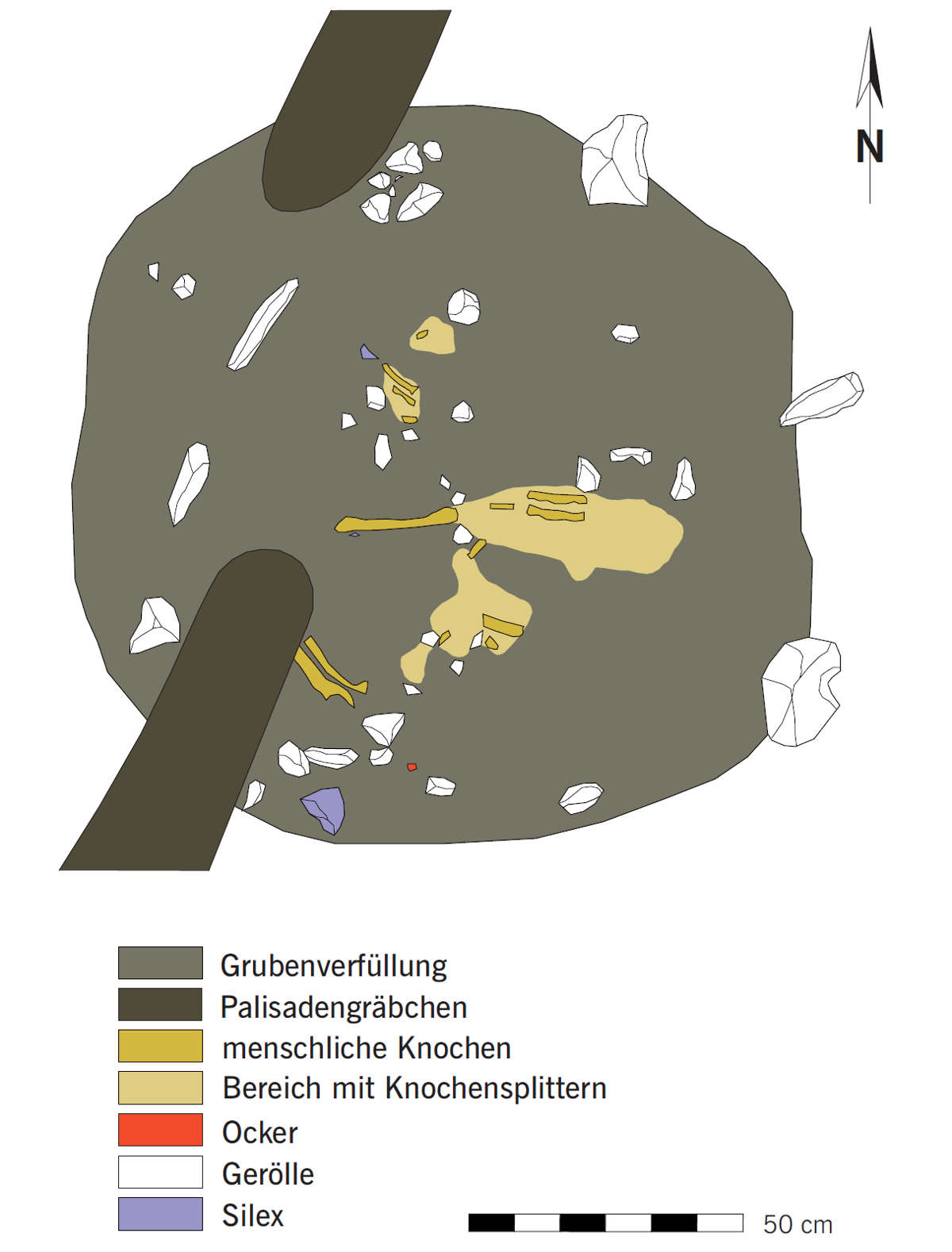
![[Translate to English:] Verzierte Wandscherbe der Stichbandkeramik. Durch den hohen Kaolinanteil ist der Scherben sehr helltonig. [Translate to English:] Verzierte Wandscherbe der Stichbandkeramik. Durch den hohen Kaolinanteil ist der Scherben sehr helltonig.](/fileadmin/media/goseck/funde/goseck_hk_2005_150_b_1200x1600.jpg)
